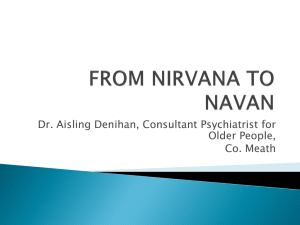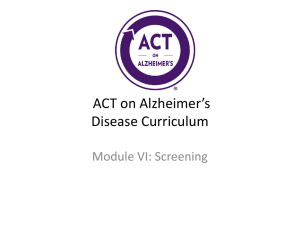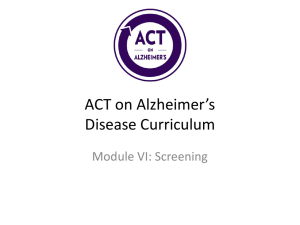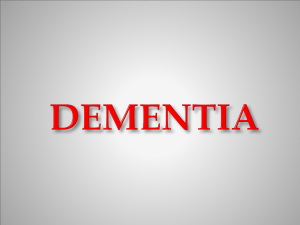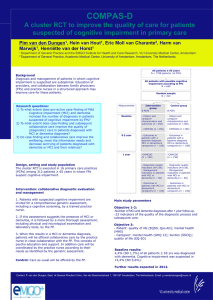PMA 2020 Alzheimer`s Disease Curricula
advertisement
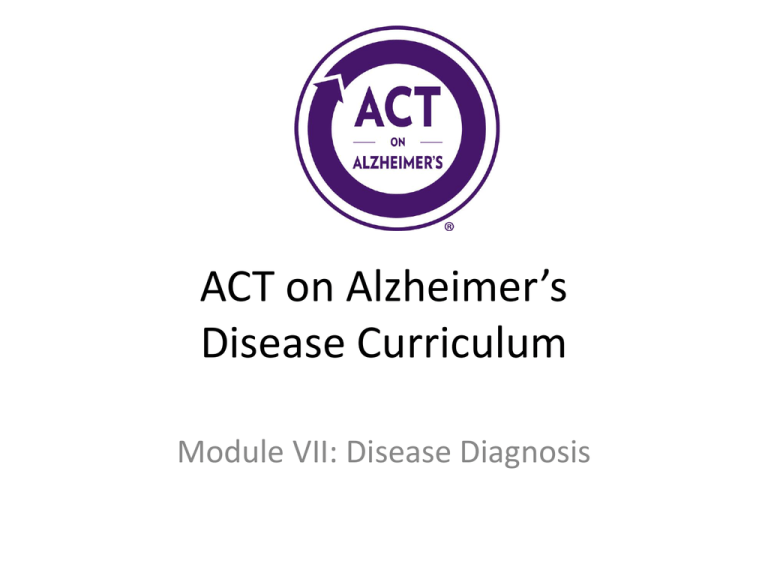
ACT on Alzheimer’s Disease Curriculum Module VII: Disease Diagnosis Disease Diagnosis • These slides are based on the Module VII: Disease Diagnosis text • Please refer to the text for all citations, references and acknowledgments 2 Module VII: Learning Objectives Upon completion of this module the student should: •Identify screenings and examinations used to diagnose and assess current state of cognitive functioning. •Gain an understanding of the benefits of early diagnosis. •Understand the steps involved in identifying and diagnosing Alzheimer’s and related dementias. Disease Diagnosis • A dementia or Alzheimer’s disease diagnosis is most commonly made by a specialist, such as neurologist, geriatrician, or geriatric psychiatrist • A diagnosis requires the collection of both subjective and objective information Disease Diagnosis • A Minnesota collaboration known as ACT on Alzheimer's has developed a Clinical Provider Practice Tool which consists of four steps: – Obtain patient history and perform a neurological examination – Gather further diagnostics to address other potential causes of dementia – Review objective and subjective data to establish a diagnosis – Organize a meeting with the patient and family to discuss diagnosis, prognosis and treatment strategy Step 1 – Medical History • Step 1 begins with obtaining a medical history of the patient • The major historical elements to cover in a medical history include: – Symptom quality – Symptom onset – Course – Impact on social/occupational function Step 1 – Medical History • Step 1 continues with a cognitive review of systems • A complete cognitive review should be performed to assess: – Memory – Executive function – Language – Visuospatial function Step 1 – Medical History • The third phase of Step 1 is to conduct a neurological examination • A neurological exam is used to assess mental status, rule out a stroke and assess for parkinsonism • A neurological examination includes: mental status, cranial nerve evaluation, motor and coordination exam, sensory evaluation, testing of reflexes and gait assessment Step 1 – Medical History • The last element of Step 1 is cognitive assessment and cognitive screening • In contrast to neuropsychological testing, cognitive screening does not confirm a diagnosis • There are multiple cognitive assessment tools that are available to providers Step 1 – Medical History • There are a wide range of cognitive assessment options – Mini-Cog – Mini-Mental State Exam (MMSE) – St. Louis University Mental Status Exam (SLUMS) – Montreal Cognitive Assessment (MoCA) – Kokmen Test of Mental Status Mini-Cog • Mini-Cog is a five point cognitive screen – 3 word verbal recall – Clock draw • Takes 1.5 to 3 minutes • Short administration time makes it ideal for rushed primary care settings Mini-Cog • Pros Takes only 1.5-3 minutes to administer Clock drawing sensitive to both visuospatial & executive dysfunction Simple scoring and interpretation • Cons Not considered as sensitive for MCI or early dementia when compared to longer screens Brevity means less information to interpret MMSE • Mini Mental Status (MMSE) is one of the most widely used cognitive assessment tools • Test has a 30 point scale and tests orientation, memory, visuospatial, construction and language • Takes seven minutes to administer MMSE • Pros Widely accepted and validated tool for dementia screening 30-point scale well known and score is easily interpretable Measures orientation, working memory, recall, language, praxis • Cons Scale developed 40 years ago, before MCI criteria and when early dementia less well understood Lacks sensitivity to MCI and early dementia Takes 7 min. to administer Copyright issues SLUMS • The St. Louis University Mental Status Exam (SLUMS) was one of the first cognitive assessment tools to address MCI • Test has a 30 point scale • Takes 10 minutes to administer SLUMS • Pros More measures of executive functioning Good balance between easy and difficult items More sensitive than MMSE in detecting MCI and early dementia 30-point scale similar to MMSE Score range for MCI and dementia Free online • Cons Takes 10 min. to administer Slightly more complex directions than MMSE Less name recognition than MMSE MoCA • The Montreal Cognitive Assessment (MoCA) was developed at the Montreal Neurological Institute • MoCA is one of the most sensitive cognitive screens available • Takes 12-15 minutes to administer • Tests executive function in addition to language, visuospatial function and memory MoCA • Pros Much more sensitive than MMSE in detecting MCI and early dementia More content tapping higher level executive functioning 30-point scale similar to MMSE Translations available in 35+ languages Free online • Cons Takes 10-14 min. to administer More complex administration and directions than MMSE Kokmen Test of Mental Status • The Kokmen Test was developed at the Mayo Clinic • Has a 38 point scale • Takes longer than the MMSE to administer • More sensitive to MCI by including a longer word list for recall Step 1 – Medical History • The decision to proceed to neuropsychological testing is a function of a patient’s score on a cognitive assessment as well as the patient’s medical history • Formal neuropsychological is recommended for individuals scoring in the following ranges: – MoCA: 19-27 – SLUMS: 18-27 – MMSE: 18-28 Step 2 – Diagnostic Evaluation • Step 2 involves a diagnostic evaluation • After completing Step 1 which includes medical history, examination and cognitive screening, the provider should obtain objective studies to rule out reversible causes of dementia • The diagnostic evaluation outlined in Step 2 includes laboratory studies, neuroimaging and neuropsychological testing Step 2 – Diagnostic Evaluation • The purpose of obtaining the laboratory studies is to rule out reversible causes of dementia • Approximately 9% of dementias are reversible Step 2 – Diagnostic Evaluation • The American Academy of Neurology recommends neuroimaging for all individuals undergoing a dementia evaluation • This imaging may involve a CT scan or an MRI • The main purpose of the imaging is to rule out a structural lesion that could be the cause of the dementia Step 2 – Diagnostic Evaluation • The third phase of the diagnostic evaluation includes neuropsychological testing • Neuropsychological testing focuses on brain function • Neuropsychological testing can help determine whether memory changes are normal age-related changes or a neurological disorder Step 2 – Diagnostic Evaluation • A neuropsychologist utilizes a battery of tests to address the same cognitive modalities addressed in the cognitive review – Learning / memory – Executive function – Language – Visuospatial function – Mood and personality Step 3 – Establish Diagnosis • A neurodegenerative disease diagnosis requires a provider to integrate elements from the previous two steps: – – – – – – Clinical history Neurological exam Cognitive screening Laboratory studies Neuropsychological testing Neuroimaging • Alzheimer’s disease accounts for 60-80% of dementia cases Step 3 – Establish Diagnosis • Providers successfully diagnose Alzheimer’s disease only 50% of the time • There are numerous barriers to an effective diagnosis – – – – – – – Insufficient training, knowledge Belief that there are no effective treatments Time constraints Insufficient reimbursement Disclosure discomfort Fear of individual, family reaction Belief that specialists are more appropriate to make diagnosis – Association of dementia with the geriatric population Step 3 – Establish Diagnosis • There are other causes, other than dementia, that may result in memory loss: – – – – – – – – – – Vascular Infectious Toxic Autoimmune Metabolic Neoplastic Traumatic Endocrine Episodic Neurodegenerative Step 4 – Family Meeting • Following a dementia diagnosis, the provider should arrange a family meeting • During the meeting the following should be addressed: – Communicate the diagnosis – Discuss potential interventions – Provide suggestions for disease management • Ideally the meeting is multidisciplinary including physician, social worker and neuropsychologist Step 4 – Family Meeting • Studies have shown meaningful benefits of providing a wide array of services and interventions – Appropriate use of available treatment options (pharmacological and non-pharmacological) – Effective management of coexisting conditions – Coordination of care among providers – Referral to community-based resources – Participation in activities that enhance quality of life Step 4 – Family Meeting • The individual and families benefit from an early diagnosis. Benefits include: – – – – – – – – – Rule out other causes Start treatment early Manage co-existing conditions Understand symptoms and how to manage them Plan for the future Build a support system Lower anxiety Avoid crisis driven care Participate in clinical trials or other research
